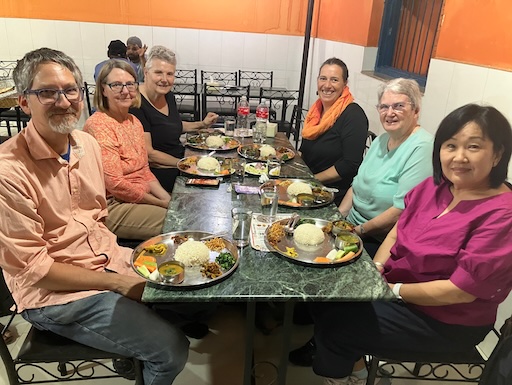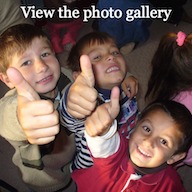Since Mitch’s last blog post, three weeks have gone by in a whirlwind. October 19, the day Mitch wrote, ended our Dashain holiday time. Following those holidays the kids went back to school and on Sunday the 20th we jumped right into learning review. Yes, a Sunday work day. This is not usual for us.
For me, being at the office in meetings every day for a week from 8:30-5:00 was pretty exhausting. I don’t usually do that, and actually, neither does Mitch. I also think the 90% Nepali input with some whispered translation from our Nepali colleagues added to the exhaustion. However, both Mitch and I are also delighted with how much Nepali we could follow, especially with an English word thrown in here and there and (at the same time) discouraged by how little we understood. Two of our other non-Nepali colleagues also needed translation (one of whom has been in the country 10 years!) so that did make us feel a little bit better.
The learning review began with two days of storytelling and reports from the Field and the Hospitals. It then shifted to strategic planning and the following week held two days of all-staff continuing education training. UMN really puts a lot of work into filling the time when all of the staff are together! It was inspiring and encouraging to hear the stories of the good work that UMN is doing. I was especially inspired by the connections with churches and community leaders including pastors to help educate and create groups to support men and women in addressing toxic masculinity and decreasing domestic violence and child marriage. There were also stories of work in rehabilitation, maternal and child health, conflict resolution etc. If you are interested in more stories about the work of UMN there is a new website with stories and videos directly connected to each of our working areas which can be found here (scroll down to find the area you are most interested in and click through to find the stories).
Each morning began with a forty-minute devotion focused on one of UMN’s values. I was invited to lead a devotion on Peace and Reconciliation and was glad to share some about our Mennonite tradition and ways that we can read and tell the stories of the Bible to encourage dignity and peace in individuals and the community. The introductory/first minute of my devotion was in Nepali. I was pretty proud of myself and even though the sentences were basic, I was smooth in their presentation (there is a video below as a self-congratulatory pat on the back!)
The week was also full of social connection and fun, including meals and long tea breaks each day. In the evening there was a futsal tournament and Mitch played on the old men’s team and he felt the pain of it the next day! On Friday all of the staff packed into buses early in the morning and headed to Dhulikhel to a hotel for a day of staff fun. The Bhetghat! The day included minute-to-win-it-type games, a talent show, some staff awards, a hike and eating together.
After the learning review and two days of training for Mitch and me, we had one more day of work before more holidays! The kids were at school for 8 days between one break and the next! On that final day of work, while Mitch wildly tried (unsuccessfully) to catch up on email, I had an opportunity to preach for a graduation ceremony of the intern/trainee program. It was a lot of fun. The morning of the graduation, the streets suddenly became a riot of colour with flowers and lights showing up for the Tihar festivities.
 The Tihar festival is a five-day spiritual and cultural festival of lights. It is kind of like Diwali (in India), it is marked by lighting oil lamps inside and outside the home (and putting up lots and lots of sparkling string of what I would call “Christmas lights”! According to Wikipedia, “Unlike Diwali, the five days of Tihar include the celebration of the four creatures associated with the God of death Yama , with the final day reserved for people themselves.[1] Nepalis also make patterns on the floors of living rooms or courtyards using materials such as coloured rice , dry flour , coloured sand or flower petals , called Rangoli , as a sacred welcoming for the gods and goddesses, particularly Lakshmi .[5] For five days, people decorate their homes, and light diyo, candles, and/or strings of electric lights around the house in the evenings. As Lakshmi puja falls on the new moon night, which is the darkest night of the lunar month, people light those diyo, candles, etc. to remove the darkness and bring the light to home to welcome the goddess Lakshmi (Goddess of wealth).”
The Tihar festival is a five-day spiritual and cultural festival of lights. It is kind of like Diwali (in India), it is marked by lighting oil lamps inside and outside the home (and putting up lots and lots of sparkling string of what I would call “Christmas lights”! According to Wikipedia, “Unlike Diwali, the five days of Tihar include the celebration of the four creatures associated with the God of death Yama , with the final day reserved for people themselves.[1] Nepalis also make patterns on the floors of living rooms or courtyards using materials such as coloured rice , dry flour , coloured sand or flower petals , called Rangoli , as a sacred welcoming for the gods and goddesses, particularly Lakshmi .[5] For five days, people decorate their homes, and light diyo, candles, and/or strings of electric lights around the house in the evenings. As Lakshmi puja falls on the new moon night, which is the darkest night of the lunar month, people light those diyo, candles, etc. to remove the darkness and bring the light to home to welcome the goddess Lakshmi (Goddess of wealth).”
One of the things I love here, is that the festivals are celebrated with delight and intensity, but they come and go, so unlike Christmas, the lights are up here for the time of the festival and leave quickly afterwards. The fleeting nature festival makes it in some ways so special.
This week we had the wonderful opportunity to meet with four women from The Presbyterian Church in Canada’s Women’s Missionary Society. They delivered some treats, (cheddar cheese, Wonderbars and boxes of mac and cheese!). We had a great day and a half with them. They got to meet with Dhana Lama, UMN executive director, to hear about the history and work of UMN and we got to tell them our experience, go out to eat and do some fair-trade shopping. I hope the rest of their visit to Nepal goes well!



